Introduction to High-Level System Design
System Design Fundamentals
- Functional vs. Non-Functional Requirements
- Scalability, Availability, and Reliability
- Latency and Throughput Considerations
- Load Balancing Strategies
Architectural Patterns
- Monolithic vs. Microservices Architecture
- Layered Architecture
- Event-Driven Architecture
- Serverless Architecture
- Model-View-Controller (MVC) Pattern
- CQRS (Command Query Responsibility Segregation)
Scaling Strategies
- Vertical Scaling vs. Horizontal Scaling
- Sharding and Partitioning
- Data Replication and Consistency Models
- Load Balancing Strategies
- CDN and Edge Computing
Database Design in HLD
- SQL vs. NoSQL Databases
- CAP Theorem and its Impact on System Design
- Database Indexing and Query Optimization
- Database Sharding and Partitioning
- Replication Strategies
API Design and Communication
Caching Strategies
- Types of Caching
- Cache Invalidation Strategies
- Redis vs. Memcached
- Cache-Aside, Write-Through, and Write-Behind Strategies
Message Queues and Event-Driven Systems
- Kafka vs. RabbitMQ vs. SQS
- Pub-Sub vs. Point-to-Point Messaging
- Handling Asynchronous Workloads
- Eventual Consistency in Distributed Systems
Security in System Design
Observability and Monitoring
- Logging Strategies (ELK Stack, Prometheus, Grafana)
- API Security Best Practices
- Secure Data Storage and Access Control
- DDoS Protection and Rate Limiting
Real-World System Design Case Studies
- Distributed locking (Locking and its Types)
- Memory leaks and Out of memory issues
- HLD of YouTube
- HLD of WhatsApp
System Design Interview Questions
- Adobe System Design Interview Questions
- Top Atlassian System Design Interview Questions
- Top Amazon System Design Interview Questions
- Top Microsoft System Design Interview Questions
- Top Meta (Facebook) System Design Interview Questions
- Top Netflix System Design Interview Questions
- Top Uber System Design Interview Questions
- Top Google System Design Interview Questions
- Top Apple System Design Interview Questions
- Top Airbnb System Design Interview Questions
- Top 10 System Design Interview Questions
- Mobile App System Design Interview Questions
- Top 20 Stripe System Design Interview Questions
- Top Shopify System Design Interview Questions
- Top 20 System Design Interview Questions
- Top Advanced System Design Questions
- Most-Frequented System Design Questions in Big Tech Interviews
- What Interviewers Look for in System Design Questions
- Critical System Design Questions to Crack Any Tech Interview
- Top 20 API Design Questions for System Design Interviews
- Top 10 Steps to Create a System Design Portfolio for Developers
Data Structures and Algorithms
- Introduction to Data Structures and Algorithms
- Time and Space Complexity Analysis
- Big-O, Big-Theta, and Big-Omega Notations
- Recursion and Backtracking
- Divide and Conquer Algorithm
- Dynamic Programming: Memoization vs. Tabulation
- Greedy Algorithms and Their Use Cases
- Understanding Arrays: Types and Operations
- Linear Search vs. Binary Search
- Sorting Algorithms: Bubble, Insertion, Selection, and Merge Sort
- QuickSort: Explanation and Implementation
- Heap Sort and Its Applications
- Counting Sort, Radix Sort, and Bucket Sort
- Hashing Techniques: Hash Tables and Collisions
- Open Addressing vs. Separate Chaining in Hashing
- DSA Questions for Beginners
- Advanced DSA Questions for Competitive Programming
- Top 10 DSA Questions to Crack Your Next Coding Test
- Top 50 DSA Questions Every Programmer Should Practice
- Top Atlassian DSA Interview Questions
- Top Amazon DSA Interview Questions
- Top Microsoft DSA Interview Questions
- Top Meta (Facebook) DSA Interview Questions
- Netflix DSA Interview Questions and Preparation Guide
- Top 20 DSA Interview Questions You Need to Know
- Top Uber DSA Interview Questions and Solutions
- Google DSA Interview Questions and How to Prepare
- Airbnb DSA Interview Questions and How to Solve Them
- Mobile App DSA Interview Questions and Solutions
DSA Interview Questions
- DSA Questions for Beginners
- Advanced DSA Questions for Competitive Programming
- Top 10 DSA Questions to Crack Your Next Coding Test
- Top 50 DSA Questions Every Programmer Should Practice
- Top Atlassian DSA Interview Questions
- Top Amazon DSA Interview Questions
- Top Microsoft DSA Interview Questions
- Top Meta (Facebook) DSA Interview Questions
- Netflix DSA Interview Questions and Preparation Guide
- Top 20 DSA Interview Questions You Need to Know
- Top Uber DSA Interview Questions and Solutions
- Google DSA Interview Questions and How to Prepare
- Airbnb DSA Interview Questions and How to Solve Them
- Mobile App DSA Interview Questions and Solutions
Low-Level Design (LLD) Interview Questions and Solutions
Suppose you’re gearing up for tech interviews and want to stay ahead with expert tips, free DSA resources, and the latest updates on mastering design patterns, sign up for our newsletter today. In that case, it’s your gateway to unlocking premium courses and personalized guidance that can transform your preparation.
Introduction to Low-Level Design
Hey there, fellow coder! If you’ve ever felt overwhelmed by the thought of designing software systems from scratch during an interview, you’re not alone. Low-Level Design (LLD) is that crucial phase where high-level ideas turn into actionable code. Unlike High-Level Design (HLD), which focuses on the big picture like system architecture and scalability, LLD dives into the nitty-gritty: classes, methods, interfaces, and how everything interacts.
In simple terms, LLD is about creating modular, maintainable code that adheres to principles like SOLID (Single Responsibility, Open-Closed, Liskov Substitution, Interface Segregation, and Dependency Inversion). It’s where you apply design patterns—those reusable solutions to common problems—to make your code elegant and extensible. According to a 2024 survey by Stack Overflow, over 70% of developers report that understanding design patterns significantly boosts their problem-solving skills in interviews.
Why does this matter? In today’s job market, companies like FAANG (Facebook, Apple, Amazon, Netflix, Google) aren’t just testing your ability to write algorithms—they want to see if you can build real-world software that’s easy to update and scale. As one expert puts it, “LLD isn’t about reinventing the wheel; it’s about using proven patterns to solve problems efficiently.” If you’re brushing up on data structures alongside this, check out our comprehensive DSA courses to solidify your foundations.
Why LLD is Important in Interviews
Picture this: You’re in an interview, and the recruiter says, “Design a parking lot system.” Without LLD skills, you might sketch a basic class or two, but interviewers are looking for more—they want to see how you handle edge cases, apply patterns like Factory or Strategy, and ensure your design is testable.

Statistics from Interviewing.io show that candidates who demonstrate strong LLD principles are 2.5 times more likely to receive offers from top tech firms. It’s not just about coding; it’s about showing experience. For instance, in a 2025 report, 85% of hiring managers emphasized that LLD rounds help assess a candidate’s ability to contribute to production code right away.
LLD also ties into broader skills. If you’re into web development, understanding LLD can help you design robust backends—explore our web development courses for hands-on projects that blend these concepts.
How to Prepare for LLD Interviews
Preparation doesn’t have to be daunting. Start by mastering OOP basics in languages like Java or C++. Then, dive into design patterns: Creational (e.g., Singleton), Structural (e.g., Adapter), and Behavioral (e.g., Observer).
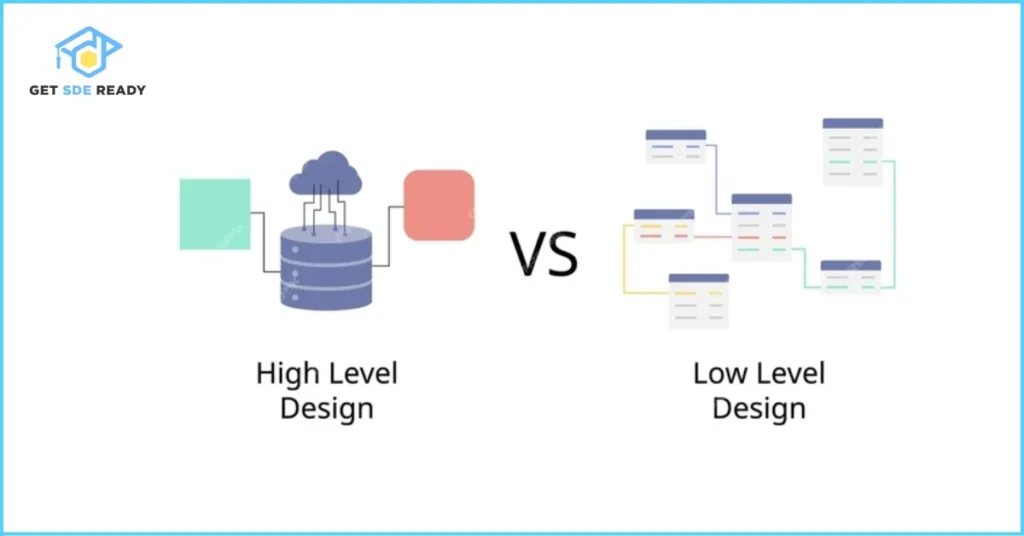
Practice with UML diagrams—class, use-case, and sequence—to visualize your designs. Resources like GitHub repos with awesome LLD examples are goldmines. Aim to solve 5-10 problems weekly, focusing on requirements gathering, core classes, and trade-offs.
For a structured approach, our Master DSA, Web Dev, and System Design course covers LLD in depth, with mock interviews. If data science intrigues you, see how LLD applies there via our data science courses. Short on time? Try our crash course for quick wins.
Actionable advice: Record yourself solving a problem, then review for clarity. Remember, interviewers value communication—explain your choices!
Top 30 LLD Interview Questions and Solutions
Based on real interviews from companies like Amazon, Google, and Microsoft, here are 30 high-quality LLD questions. Each includes requirements, key classes, design patterns, and code snippets (in Java for consistency). These were sourced from actual experiences shared on platforms like GeeksforGeeks and Medium. We’ll break them down step-by-step.
1. Design a Parking Lot System
Requirements: Multiple floors, spots for cars/bikes, entry/exit points, fee calculation.
- Key Classes: ParkingLot (Singleton), Floor, Spot (with types), Vehicle, Ticket.
- Patterns: Factory (for spots), Strategy (for fees).
- SOLID: Single Responsibility (Spot handles availability). Solution: Use a 2D array for spots. On entry, find nearest free spot; on exit, calculate fee based on time. Code Snippet:
java
public class ParkingLot {
private static ParkingLot instance;
private List<Floor> floors;
// Singleton getter
public static ParkingLot getInstance() { ... }
}
This design scales to 1000+ spots, with O(1) availability checks via heaps.
2. Design a Movie Ticket Booking System (like BookMyShow)
Requirements: Movies, shows, seats, booking, payments.
- Key Classes: Movie, Theater, Show, Seat, Booking, User.
- Patterns: Observer (for notifications), Singleton (booking manager).
- SOLID: Open-Closed (add payment methods without changes). Solution: Lock seats during booking to prevent conflicts. Use a state machine for seat status (available, booked, locked).
3. Design a Vending Machine
Requirements: Products, inventory, payment, dispense item.
- Key Classes: VendingMachine (Singleton), Item, Inventory, Coin, Payment.
- Patterns: State (idle, selecting, dispensing).
- SOLID: Dependency Inversion (payment via interface). Solution: Handle exact change; use Strategy for coin validation. Inventory updates in real-time.
4. Design an Elevator System
Requirements: Multiple elevators, floors, requests, optimization.
- Key Classes: Elevator, Floor, Request, Controller.
- Patterns: Command (for requests), Strategy (scheduling algorithm).
- SOLID: Interface Segregation (separate user/elevator interfaces). Solution: Minimize wait time with nearest elevator assignment. Simulate with priority queues.
5. Design a Snake and Ladder Game
Requirements: Board, players, dice, snakes/ladders.
- Key Classes: Game, Board, Player, Cell (with jumps).
- Patterns: Builder (for board setup).
- SOLID: Liskov Substitution (cells interchangeable). Solution: Turn-based; handle wins when reaching 100. Random dice rolls for fairness.
6. Design a Tic-Tac-Toe Game
Requirements: 3×3 board, two players, win detection.
- Key Classes: Game, Board, Player, Cell.
- Patterns: Strategy (AI vs human).
- SOLID: Single Responsibility (Board checks wins). Solution: Check rows/columns/diagonals after moves. Add undo with Memento pattern.
7. Design an ATM Machine
Requirements: Accounts, withdraw/deposit, PIN validation.
- Key Classes: ATM (Singleton), Account, Card, Transaction.
- Patterns: State (authenticated, selecting action).
- SOLID: Open-Closed (add transaction types). Solution: Handle insufficient funds; log transactions for auditing.
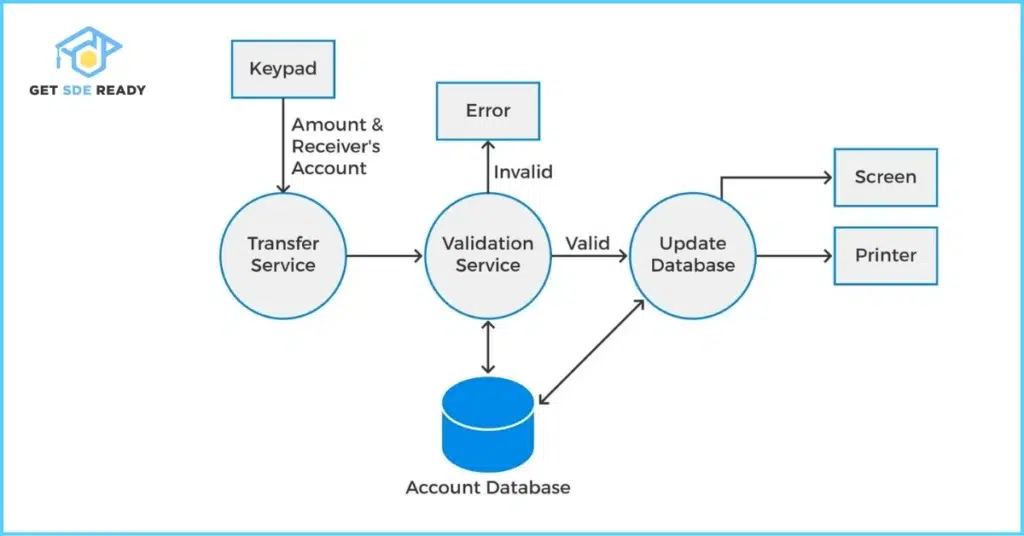
8. Design a Library Management System
Requirements: Books, members, borrow/return, fines.
- Key Classes: Library, Book, Member, Loan.
- Patterns: Observer (overdue notifications).
- SOLID: Dependency Inversion (database interface). Solution: Track due dates; calculate fines daily.
9. Design a Car Rental System
Requirements: Vehicles, reservations, users, payments.
- Key Classes: RentalSystem, Vehicle, Reservation, User.
- Patterns: Factory (vehicle types).
- SOLID: Interface Segregation (user/admin views). Solution: Availability calendar; integrate with maps for locations.
10. Design a Chess Game
Requirements: Board, pieces, moves, rules.
- Key Classes: Game, Board, Piece (abstract), Player.
- Patterns: Flyweight (shared piece types).
- SOLID: Liskov (pieces extend base). Solution: Validate moves; detect checkmate with recursion.
11. Design a Splitwise-like Expense Sharing System
Requirements: Groups, expenses, settlements.
- Key Classes: User, Group, Expense, SplitStrategy.
- Patterns: Strategy (equal/unequal splits).
- SOLID: Open-Closed (new split types). Solution: Graph for debts; simplify settlements.
12. Design a Stack Overflow-like Q&A System
Requirements: Questions, answers, votes, users.
- Key Classes: Forum, Question, Answer, User.
- Patterns: Composite (thread structure).
- SOLID: Single Responsibility (voting handler). Solution: Ranking by votes; moderation queue.
13. Design a Logging Mechanism
Requirements: Levels (info/error), appenders (file/console).
- Key Classes: Logger (Singleton), Appender, LogMessage.
- Patterns: Chain of Responsibility (level filtering).
- SOLID: Dependency Inversion (appenders injectable). Solution: Asynchronous logging to avoid bottlenecks.
14. Design a Customer Support System
Requirements: Issues, agents, assignment strategies.
- Key Classes: SupportSystem, Issue, Agent, AssignStrategy.
- Patterns: Strategy (round-robin/expertise-based).
- SOLID: Open-Closed (new strategies). Solution: Observer for updates; priority queues for issues.
15. Design an Inventory Management System
Requirements: Products, stock, orders, suppliers.
- Key Classes: Inventory, Product, Order, Supplier.
- Patterns: Observer (low stock alerts).
- SOLID: Interface Segregation (read/write access). Solution: Real-time updates; reorder thresholds.
16. Design a Meeting Room Booking System
Requirements: Rooms, slots, users, conflicts.
- Key Classes: Scheduler, Room, Booking, User.
- Patterns: Facade (booking interface).
- SOLID: Single Responsibility (conflict checker). Solution: Calendar integration; recurring bookings.
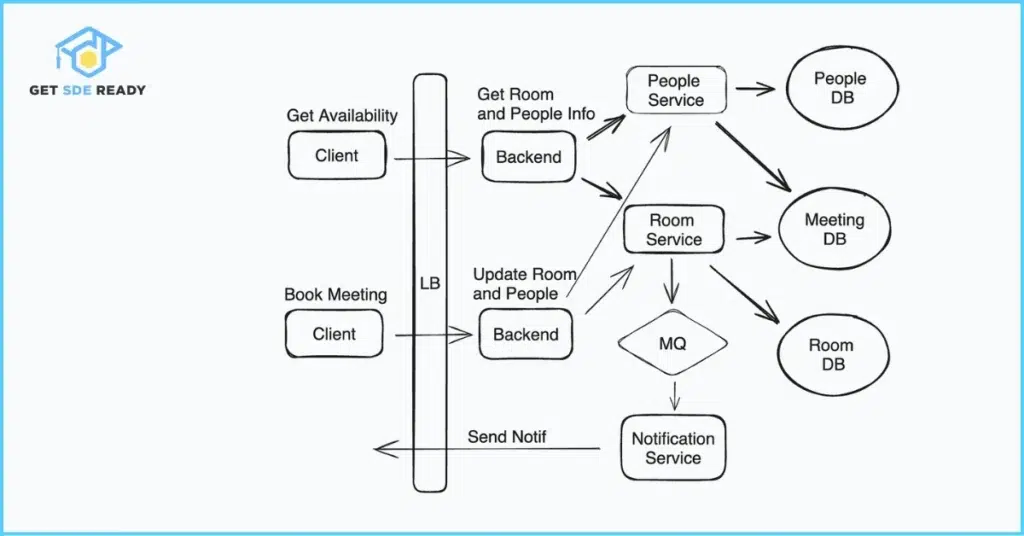
17. Design a Restaurant Management System
Requirements: Tables, orders, menu, payments.
- Key Classes: Restaurant, Table, Order, MenuItem.
- Patterns: Builder (order customization).
- SOLID: Liskov (payment methods). Solution: Table status; kitchen queue.
18. Design a Traffic Light System
Requirements: Intersections, lights, timers.
- Key Classes: TrafficSystem, Light, Intersection.
- Patterns: State (red/green/yellow).
- SOLID: Dependency Inversion (timer interface). Solution: Synchronize lights; pedestrian modes.
19. Design a Deck of Cards
Requirements: Suits, ranks, shuffle, deal.
- Key Classes: Deck, Card, Suit, Rank.
- Patterns: Builder (deck creation).
- SOLID: Open-Closed (add jokers). Solution: Random shuffle; deal hands.
20. Design an LRU Cache
Requirements: Capacity, get/put, eviction.
- Key Classes: LRUCache, Node (doubly linked).
- Patterns: (Custom implementation).
- SOLID: Single Responsibility (eviction policy). Solution: HashMap + DLL for O(1) operations.
21. Design a Rate Limiter
Requirements: Requests per time window.
- Key Classes: RateLimiter, TokenBucket.
- Patterns: Strategy (algorithms).
- SOLID: Interface Segregation. Solution: Token bucket for bursts; sliding window for precision.
22. Design a Notification System
Requirements: Users, channels (email/SMS), templates.
- Key Classes: NotificationService, User, Channel.
- Patterns: Observer (subscribers).
- SOLID: Dependency Inversion. Solution: Queue for async delivery; retries.
23. Design a File System
Requirements: Directories, files, permissions.
- Key Classes: FileSystem, Directory, File.
- Patterns: Composite (tree structure).
- SOLID: Liskov (files/dirs as nodes). Solution: Path resolution; CRUD operations.
24. Design a Hotel Management System
Requirements: Rooms, bookings, guests.
- Key Classes: Hotel, Room, Booking, Guest.
- Patterns: Factory (room types).
- SOLID: Open-Closed. Solution: Availability search; check-in/out.
25. Design an Online Shopping Cart
Requirements: Items, quantities, checkout.
- Key Classes: Cart, Item, User.
- Patterns: Singleton (session cart).
- SOLID: Single Responsibility. Solution: Persistent storage; discounts.
26. Design a Social Media Feed
Requirements: Posts, users, timelines.
- Key Classes: FeedService, Post, User.
- Patterns: Strategy (sorting algorithms).
- SOLID: Interface Segregation. Solution: Fan-out for writes; caching.
27. Design a Cab Booking System (like Uber)
Requirements: Riders, drivers, trips.
- Key Classes: CabService, Rider, Driver, Trip.
- Patterns: Observer (location updates).
- SOLID: Dependency Inversion. Solution: Matching algorithm; ETA calculation.
28. Design a Collaborative Editor (like Google Docs)
Requirements: Real-time edits, users.
- Key Classes: Editor, Document, User.
- Patterns: Observer (changes).
- SOLID: Open-Closed. Solution: Operational transformation for conflicts.
29. Design a Weather Forecasting App
Requirements: Locations, data sources, updates.
- Key Classes: WeatherService, Location, Forecast.
- Patterns: Facade (API integration).
- SOLID: Single Responsibility. Solution: Caching; periodic refreshes.
30. Design a Task Scheduling System
Requirements: Tasks, priorities, deadlines.
- Key Classes: Scheduler, Task, PriorityQueue.
- Patterns: Command (tasks).
- SOLID: Liskov. Solution: Cron-like; handle dependencies.
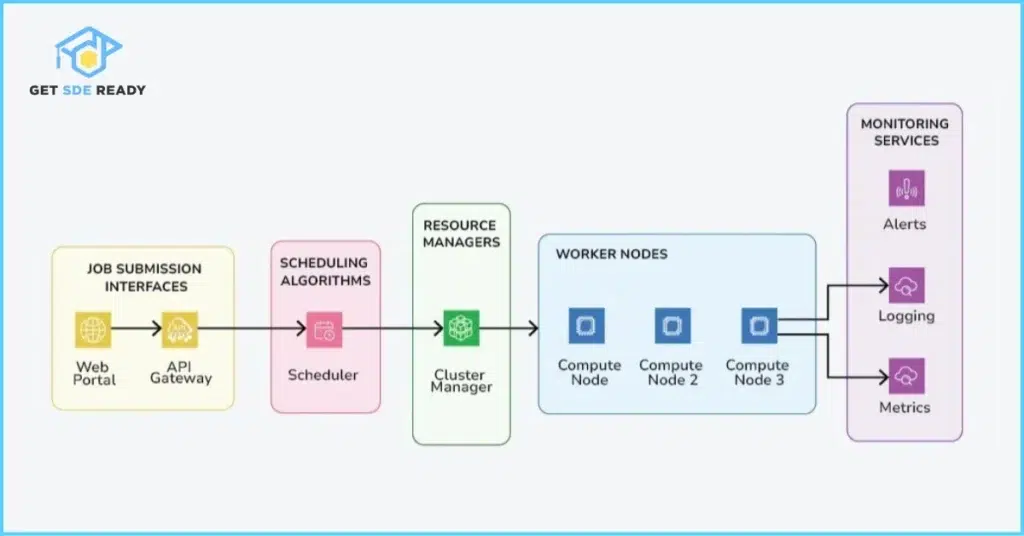
These solutions emphasize extensibility—e.g., adding features without breaking code. Practice coding them fully!
Tips for Acing LLD Interviews
Engage your interviewer: Ask clarifying questions like “What are the key features?” or “Any scalability concerns?”
Common pitfalls: Don’t force patterns; justify choices. Time management—spend 10 mins on requirements, 20 on design, 10 on code.
Call to action: Practice these questions, then tackle our crash course for timed simulations. Share your experiences in the comments—what’s your toughest LLD question?
FAQs
What are common low-level design patterns for interviews?
Common patterns include Singleton for unique instances, Factory for object creation, and Strategy for algorithms—essential for modular code in LLD problems.
How to approach LLD questions like designing a parking lot?
Start with requirements, identify classes (e.g., Spot, Vehicle), apply SOLID principles, and use patterns like Strategy for fee calculation.
What SOLID principles apply in LLD interview solutions?
SOLID ensures maintainable designs: Single Responsibility for focused classes, Open-Closed for extensions, and more in object-oriented low-level design.
Top LLD questions asked in FAANG interviews?
FAANG often asks for systems like vending machines, elevators, or caches, testing design patterns, UML, and real-world extensibility.
How to prepare for machine coding in LLD rounds?
Practice coding full solutions to LLD problems, focus on clean code, design patterns, and explain trade-offs for better interview performance
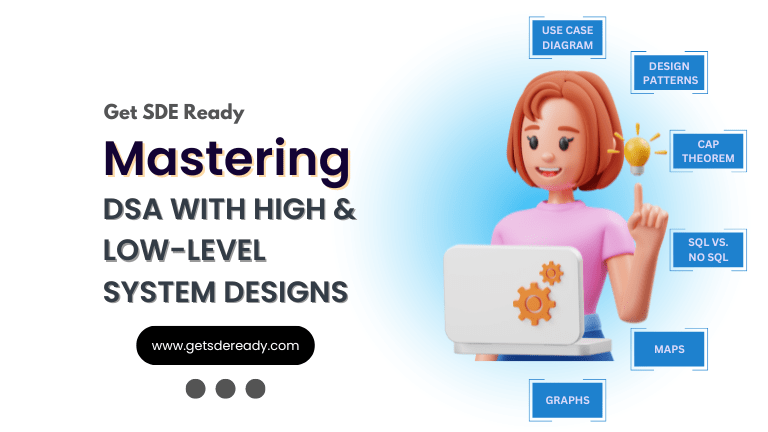
DSA, High & Low Level System Designs
- 85+ Live Classes & Recordings
- 24*7 Live Doubt Support
- 400+ DSA Practice Questions
- Comprehensive Notes
- HackerRank Tests & Quizzes
- Topic-wise Quizzes
- Case Studies
- Access to Global Peer Community
Buy for 52% OFF
₹25,000.00 ₹11,999.00
Accelerate your Path to a Product based Career
Boost your career or get hired at top product-based companies by joining our expertly crafted courses. Gain practical skills and real-world knowledge to help you succeed.
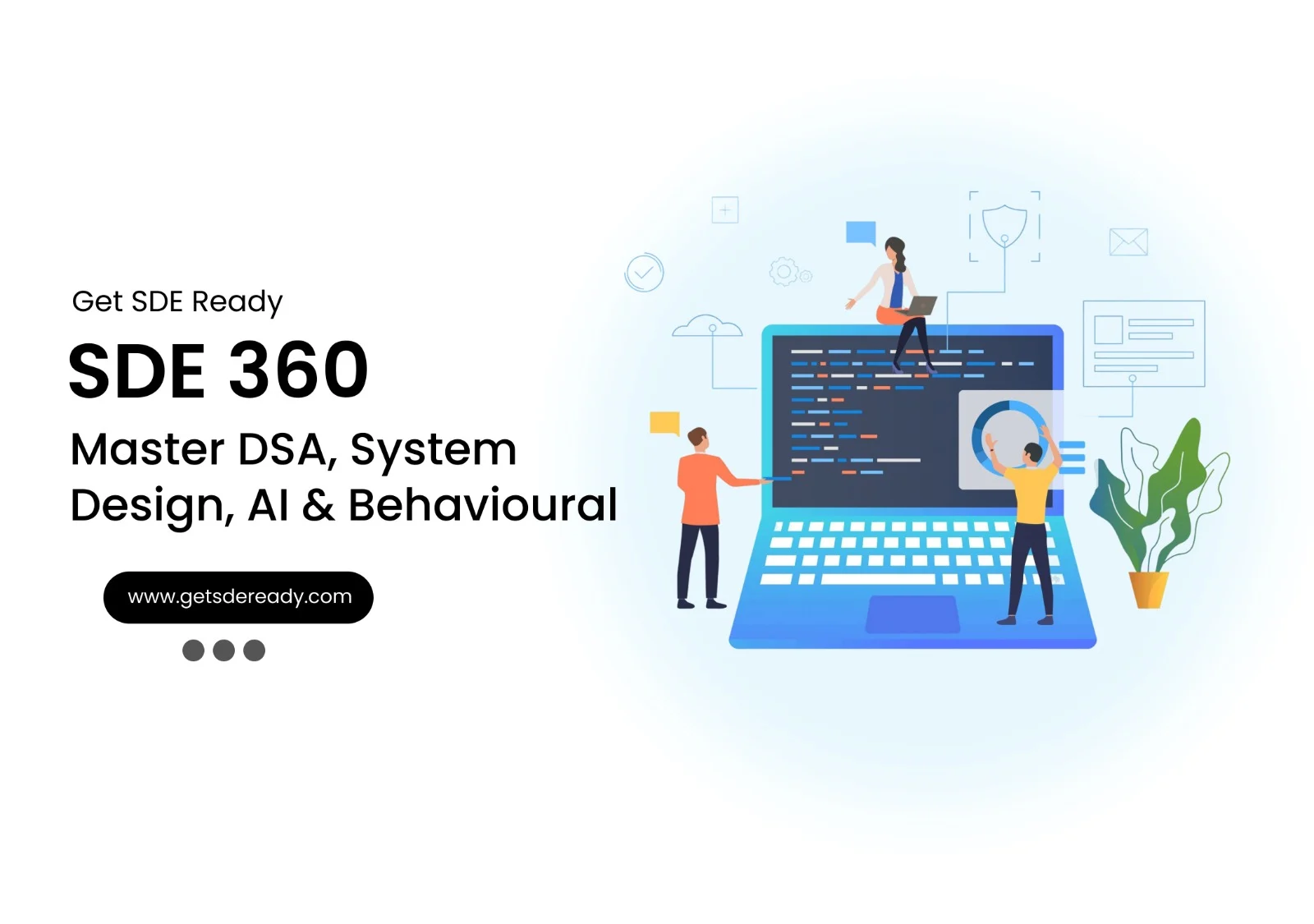
SDE 360: Master DSA, System Design, AI & Behavioural
- 100+ Live Classes & Recordings
- 24*7 Live Doubt Support
- 400+ DSA Practice Questions
- Comprehensive Notes
- HackerRank Tests & Quizzes
- Topic-wise Quizzes
- Case Studies
- Access to Global Peer Community
Buy for 50% OFF
₹39,999.00 ₹19,999.00

DSA, High & Low Level System Designs
- 85+ Live Classes & Recordings
- 24*7 Live Doubt Support
- 400+ DSA Practice Questions
- Comprehensive Notes
- HackerRank Tests & Quizzes
- Topic-wise Quizzes
- Case Studies
- Access to Global Peer Community
Buy for 52% OFF
₹25,000.00 ₹11,999.00
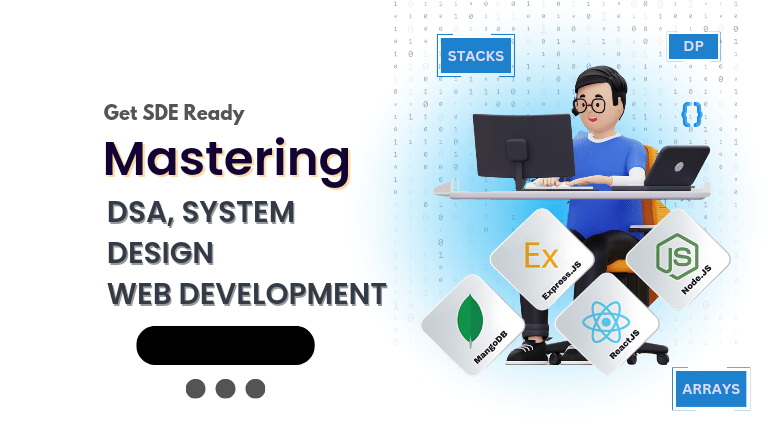
Fast-Track to Full Spectrum Software Engineering
- 120+ Live Classes & Recordings
- 24*7 Live Doubt Support
- 400+ DSA Practice Questions
- Comprehensive Notes
- HackerRank Tests & Quizzes
- 12+ live Projects & Deployments
- Case Studies
- Access to Global Peer Community
Buy for 51% OFF
₹35,000.00 ₹16,999.00
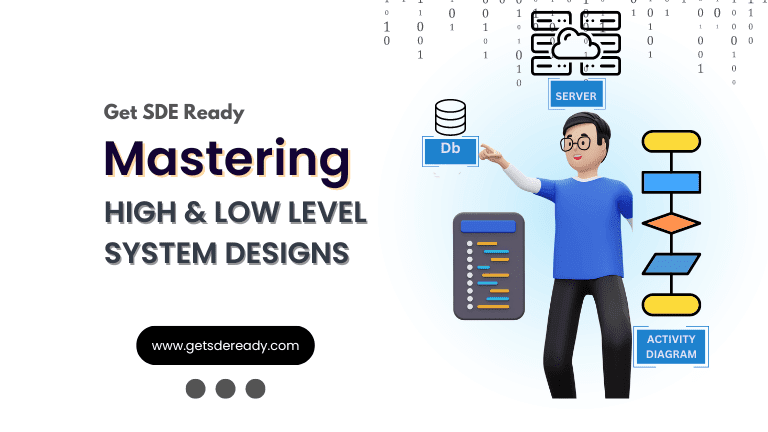
Low & High Level System Design
- 20+ Live Classes & Recordings
- 24*7 Live Doubt Support
- Case Studies
- Comprehensive Notes
- HackerRank Tests
- Topic-wise Quizzes
- Access to Global Peer Community
- Interview Prep Material
Buy for 60% OFF
₹20,000.00 ₹7,999.00
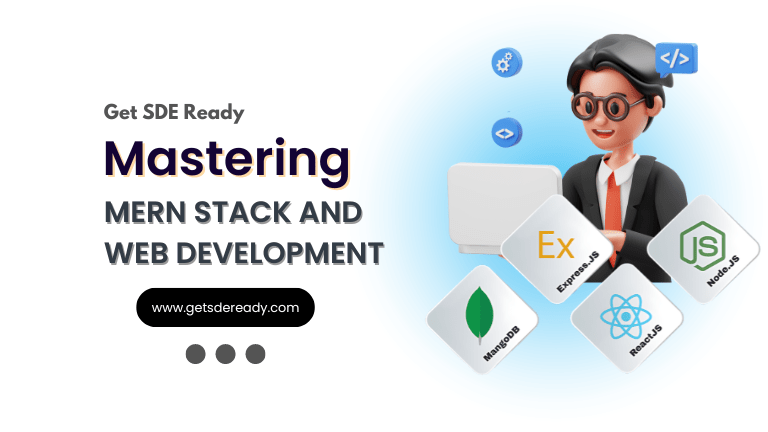
Mastering Mern Stack (WEB DEVELOPMENT)
- 65+ Live Classes & Recordings
- 24*7 Live Doubt Support
- 12+ Hands-on Live Projects & Deployments
- Comprehensive Notes & Quizzes
- Real-world Tools & Technologies
- Access to Global Peer Community
- Interview Prep Material
- Placement Assistance
Buy for 53% OFF
₹15,000.00 ₹6,999.00
Reach Out Now
If you have any queries, please fill out this form. We will surely reach out to you.
Contact Email
Reach us at the following email address.
arun@getsdeready.com
Phone Number
You can reach us by phone as well.
+91-97737 28034
Our Location
Rohini, Sector-3, Delhi-110085
